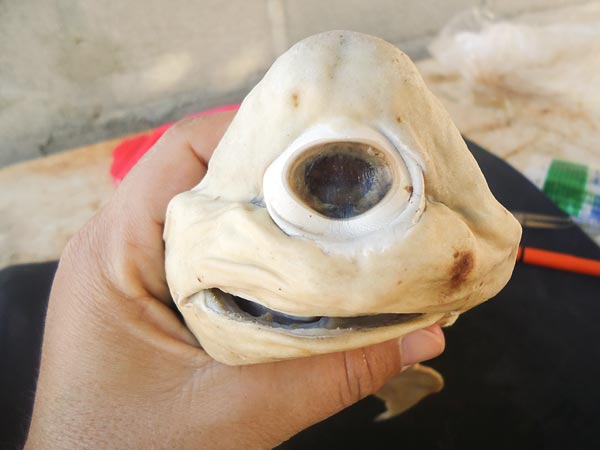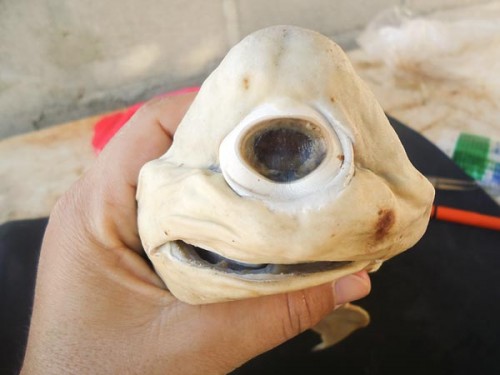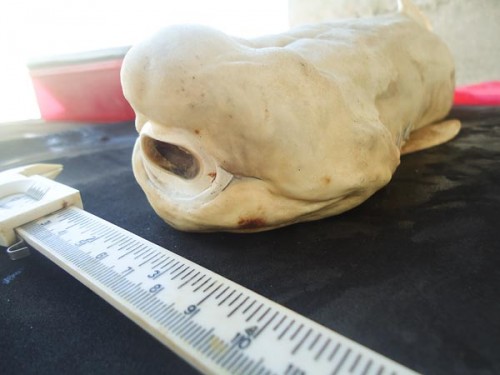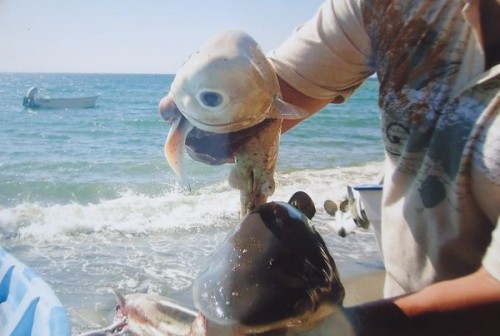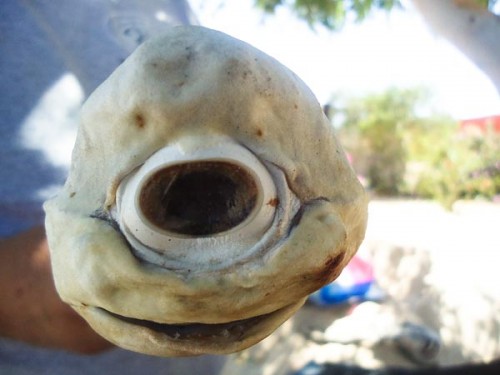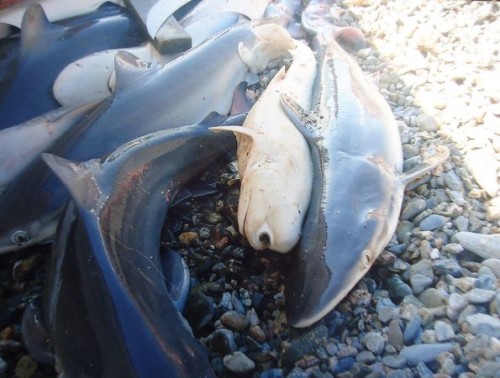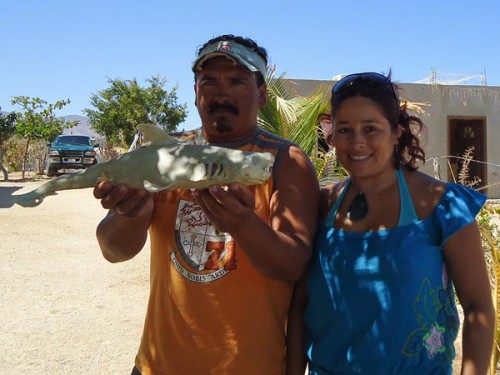“Here’s looking at you!”
When Humphrey Bogart spoke that now iconic phrase, I don’t think he was referring to a condition in nature called “Cyclopia”.
“Cyclopia is a rare form of holoprosencephaly and is a congenital disorder (birth defect) characterized by the failure of the embryonic prosencephalon to properly divide the orbits of the eye into two cavities. Its incidence is 1 in 16,000 in born animals, and 1 in 250 in embryos.”
No, I’m not going to post a ghoulish photo of a human cyclops, although the Wiki link above does reveal one on their cyclops page. What I will post are pictures of a freshly harvested Nurse Shark with this rare condition.
Here’s the National Geographic story on fishermen, Enrique Lucero León and his one in a million catch in pictures:
One-Eyed Anomaly
Talk about a one-of-a-kind discovery—an extremely rare cyclops shark (pictured) has been confirmed in Mexico, new research shows.
The 22-inch-long (56-centimeter-long) fetus has a single, functioning eye at the front of its head—the hallmark of a congenital condition called cyclopia, which occurs in several animal species, including humans.
Earlier this year fisher Enrique Lucero León legally caught a pregnant dusky shark near Cerralvo Island (see map) in the Gulf of California. When León cut open his catch, he found the odd-looking male embryo along with its nine normal siblings. “He said, That’s incredible—wow,” said biologist Felipe Galván-Magaña, of the Interdisciplinary Center of Marine Sciences in La Paz, Mexico.
Once Galván-Magaña and colleague Marcela Bejarano-Álvarez heard about the discovery—which was put on Facebook—the team got León’s permission to borrow the shark for research. The scientists then x-rayed the fetus and reviewed previous research on cyclopia in other species to confirm that the find is indeed a cyclops shark.
Cyclops sharks have been documented by scientists a few times before, also as embryos, said Jim Gelsleichter, a shark biologist at the University of North Florida in Jacksonville. The fact that none have been caught outside the womb suggests cyclops sharks don’t survive long in the wild.
Overall, finding such an unusual animal reinforces that scientists still have a lot to learn, Gelsleichter added.
“It’s a humbling experience to realize you ain’t seen it all yet.”
The Eye Has It
The cyclops shark also has other deformities, including albinism, or a total lack of tissue pigments; no nostrils; a bump on its snout; and a spinal abnormality, according to Galván-Magaña. (See more pictures of albino animals.)
A mother’s poor diet—especially a lack of vitamin A—can cause cyclopia in mammals, including people, but it’s difficult to determine the cause of the condition in sharks, he said.
Even so, Galván-Magaña suspects the defects in this case aren’t related to pollution. “The fishing area close to Baja California Sur is clear of pollution, is a pristine zone, and we cannot consider it as a cause for abnormalities in dusky sharks,” according to the study.
Stand-Out Shark
If it’d been born, the cyclops shark (pictured) likely wouldn’t have lived very long, Galván-Magaña said.
The baby’s stark white color would’ve made it more obvious to predators, and its malformed tail would’ve hindered swimming.
Aside from the handful of deformities, “the rest of the body was apparently normal,” with well-formed fins, according to the scientists’ study, which has been submitted for publication.
Black Sheep of the Family
The cyclops shark is pictured next to one of its siblings, which is normally colored, with a blue-gray back and white underside.
Dusky sharks, which average about 10 feet (3 meters) long as adults, are among the slowest growing of the shark species and can live for up to 45 years.
Often illegally harvested for its fins, the shark species is considered vulnerable by the International Union for Conservation of Nature.
Here’s Looking at You
The cyclops baby’s eye, located in the middle of its snout, is about 1 inch (2.6 centimeters) wide.
Despite its lack of nostrils, the shark’s gill slits were normal and well formed, and its mouth contained small teeth, according to the study.
Oddball Shark
Above, the albino cyclops shark lies among other captured sharks. In addition to the one eye, albinism is a rare condition among sharks, occurring more often in bony fishes, Galván-Magaña said.
There are no previous known cases of albino dusky sharks, “so this report is considered a first record of this malformation for this shark species in Mexico,” according to the study.
Fisher and His Catch
Fisher Enrique Lucero León holds the cyclops shark next to researcher Bejarano-Álvarez.
León regards the cyclops shark as a prize, Galván-Magaña said, and has already preserved his oddity in alcohol.
“Lots of people want to buy the shark, but the fisherman says no.”
Source: National Geographic
Photographs courtesy Marcela Bejarano-Álvarez

